Visual arts teams are breaking down barriers between genres and exploring new art forms. These avant-garde artists present new sensations and ways of thinking through the use of advanced technology.
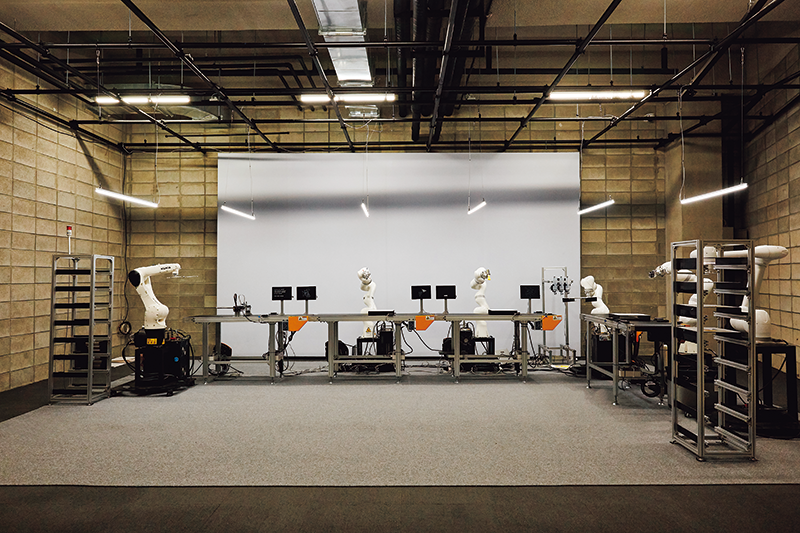
The Factory. teamVOID. 2021. Robotic arm, conveyor, drawing machine, PC, display, AL frames. Variable dimensions.
Part of teamVOID’s solo exhibition Factories, held in 2022 at ONE AND J. Gallery in Cheongdam-dong, Seoul, showcased the changing relationship between humans and machines as factory operations have become automated and upgraded.
© ONE AND J. Gallery
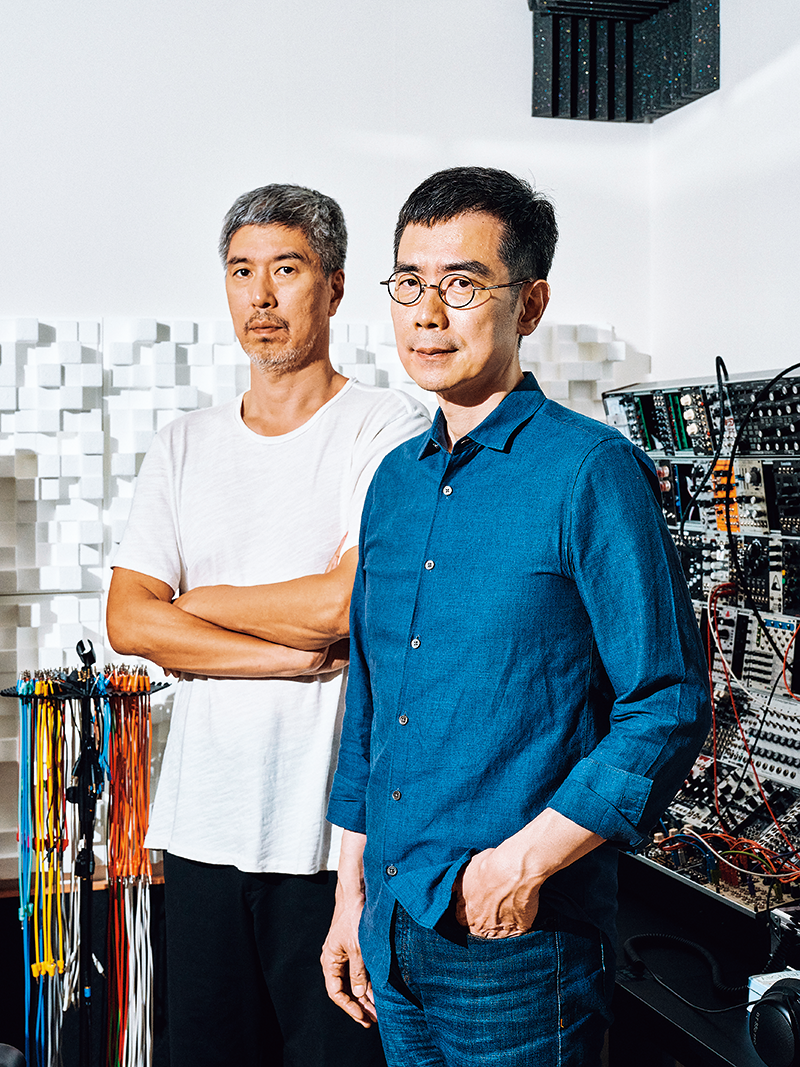
Gajaebal (left) and Jang Jae-ho formed Tacit Group, an audiovisual performance duo that draws artistic inspiration from digital technology and expresses it through multimedia performances, interactive installations, and algorithmic art using computer programming.
© Heo Dong-wuk
Tacit Group - Using Ambiguity
Tacit Group is an audiovisual performance duo consisting of composer Jang Jae-ho, who studied classical and electronic music, and Gajaebal (Lee Jinwon), an electronic musician who also dabbles in popular music. The duo, which formed in 2008, primarily experiments with algorithms, whose results are hard to predict. The approach lends itself to an innovative system that yields a different outcome every time.
Tacit Group finds its artistic possibilities in the contemporary technological environment and realizes them in the form of multimedia performances, interactive installations, and algorithmic art. They also integrate seemingly insignificant everyday moments into their work.
How did your partnership start?
We were teacher (Jang Jae-ho) and student (Gajaebal) when we first met. Around the time when kinetic art was taking off, we both took an interest in algorithmic art. Back then, it was a very difficult genre because of technical limitations of developing algorithms. We formed Tacit Group because we wanted to something that we could enjoy ourselves but also share with the public.
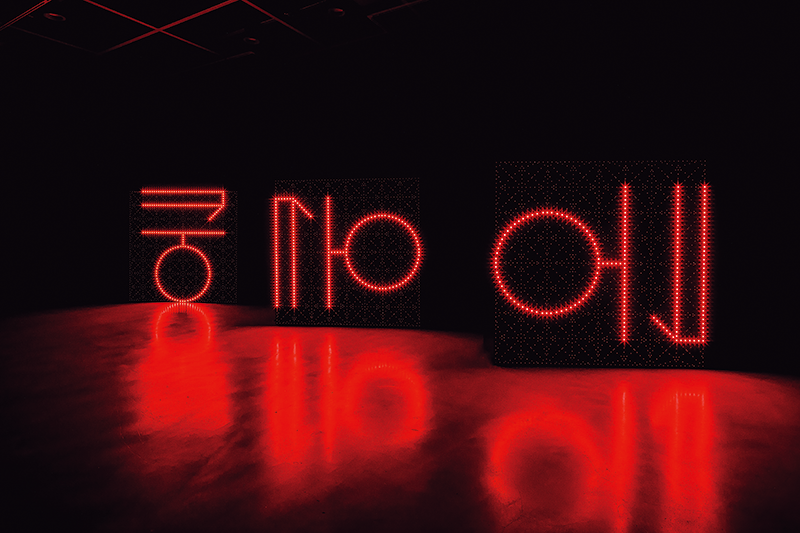
Morse ㅋung ㅋung is a work in which the consonants and vowels of the Korean alphabet are replaced with sounds. When the letters are distorted, the sounds also become distorted. The letters and sounds are meshed on three large screens that contain 2000 LEDs. Tacit Group’s artworks are d through complex algorithms.
Courtesy of Tacit Group
We took our name from John Cage’s famous musical composition
4’ 33”, which consists of four minutes and 33 seconds of silence with ambient sound of a concert hall. The manu
script for the work had one word written on it: “Tacet.” It’s a musical direction indicating that a musician is not to play for a certain amount of time. We wanted to a sensation in the 21st century just like John Cage did back in 1952.
Fifteen years ago, people were unfamiliar with the term “audiovisual” with respect to the arts, so we felt the need to explain what it meant before we could introduce our work. Now it’s no longer a strange concept, and we feel proud of our hard work that got us to this point.
Your artworks often include sounds.The Korean alphabet is often described as a system with an almost architectural structure. As a group that studies systems, we thought it would be interesting to combine Hangeul with sound, which led to the creation of
Hunmin-jeong-ak and
Morse ㅋung ㅋung. We displayed Korean consonants and vowels on a huge digital screen, where syllables would form and disintegrate, as if they were dancing.
Music often starts with inspiration rather than theory. An idea strikes you out of the blue, as was the case with
Game Over. The shapes of the game Tetris seemed to overlap with musical notes. So we used the game to sounds whose electronic notes change depending on the p and the shape and height of the blocks.
What about CRYPTO Heol Heol Heol?It was a continuation of our work with Hangeul. The interjection we make when the stock price goes up is “heol,” and we make the same sound when it collapses. “Heol,” a Korean slang term meaning “what the…?” is an exclamation that expresses positive and negative feelings. The characteristic of containing so many emotions made it a good fit for an NFT (non-fungible token). Heol itself is a sound, a medium that conveys meaning, a score, and a syllable that serves as material for music. Interestingly, if its shape is distorted a bit, it looks like a polygon.
Why use algorithms?A wind chime hanging under a roof is the perfect analogy to explain algorithmic art. Someone builds the chime, and something produces the sound. The wind cannot build a chime, but when it blows, it can sound with it. Likewise, even if the audience doesn’t know the system underpinning our works, it can still engage with our art. Our goal is to build a system that allows that to happen, although we can’t predict who will play or what tones will be produced. That’s why we put more emphasis on the process than the results.
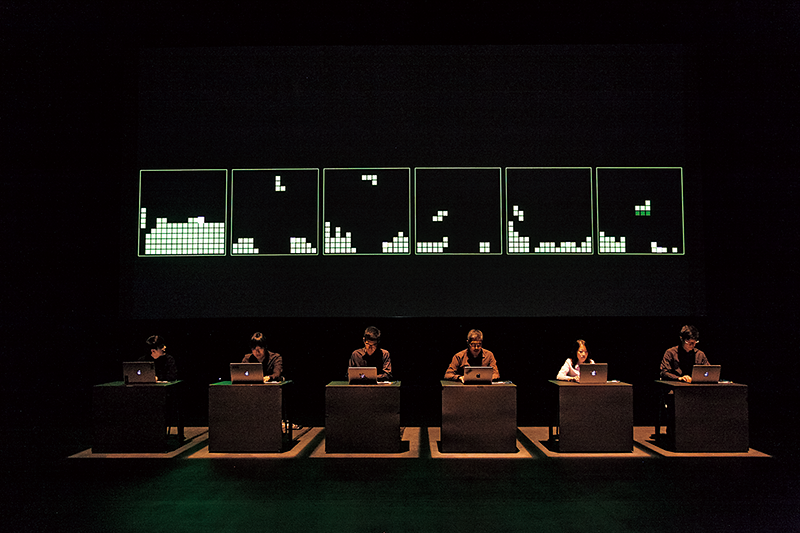
A scene from Game Over, a performance of Tacit Group that is based on the game Tetris. The gameplay is displayed overhead and different sounds are produced, depending on the location and shape of the blocks piling up.
Courtesy of Tacit Group
Hun-min-jeong-ak
Just like Morse ㅋung ㅋung, Hun-min-jeong-ak was d based on the principles behind the invention of Hangeul, the Korean alphabet. The algorithm was embedded in the consonants and vowels to produce sounds.
What has kept you going?The common denominator that binds us together as Tacit Group is that our work is motivated by ambiguity. It’s not easy to define our work as music, art, or something else entirely. It’s the journey not the answer that’s meaningful to us.
eobchae – Giving Insights
The audiovisual production collective eobchae was founded in 2017 by Kim Na-hee, Oh Cheon-seok, and Hwang Hwi. Kim and Oh were friends at university; when they met Hwang, they began planning joint projects. Today, the trio s works using various media, such as video, web art, sound, and performance, focusing on contemporary technological and cultural environments. Each member also pursues individual activities.
eobchae focuses on digital products that make modern life more convenient—smartphones, AI speakers, and the like. The collective virtually develops fake digital products to critically examine the monopoly over digital devices held by large corporations.
Why did you choose the name eobchae? When we began our creative work, the focus wasn’t on art but on creating actual products. We decided to name ourselves “eobchae” as a playful reference to commercial projects. Rather than sitting around waiting for someone to contact us, we started planning interesting work on our own.
What was your motivation? Being in a tech-related industry, we were naturally interested in digital products. However, rather than creating real products, we wanted to fakes that competed with reality. We noticed that certain digital products and apps quickly monopolized the market, making it difficult for users to escape that ecosystem. They standardize numerous aspects of modern life, like phone communications, messaging services, and payment systems.
We thought, “Let’s compete with deep-pocketed big data companies. Let’s r un at their pace.” But we knew we couldn’t actually compete with them, so we wanted to at least try to throw eggs at them by imagining fake users using fake products.
Why fake products? The process of creating illusions is fascinating—pretending something is there when it isn’t, and showing how something works when it doesn’t. Ultimately, we also want to move beyond the realm of meta-cognition and into the actual market.
Your work seems to focus a lot on the basics. We’re not interested in right and wrong, or good and evil. We’re more interested in anthropology and social sciences than in philosophy, in how much technology changes people, and what communication methods they use to pursue their desires. Today’s technological environment can be seen as another form of nature. We aim to go beyond the phenomena that lie in front of us and dig deeper into the context and background of what drives modern individuals to behave the way they do.
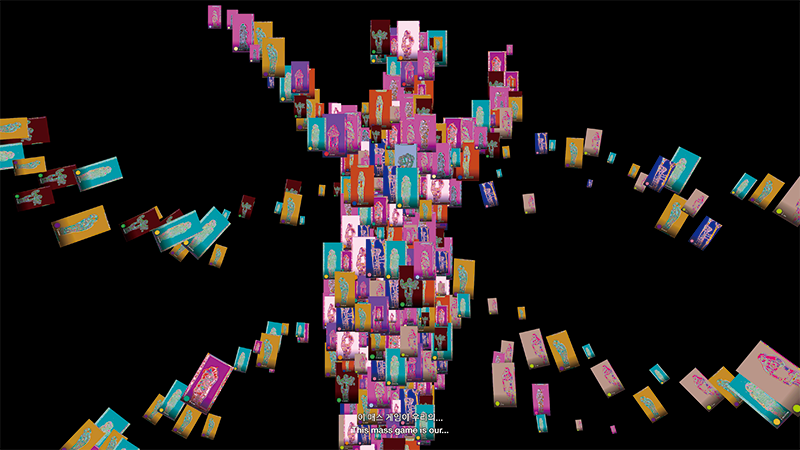
A scene from video artwork eoracle, shown at Doosan Gallery in 2022, that conveyed the world of new technologies through attractive graphics and sounds as well as storytelling.
Courtesy of eobchae
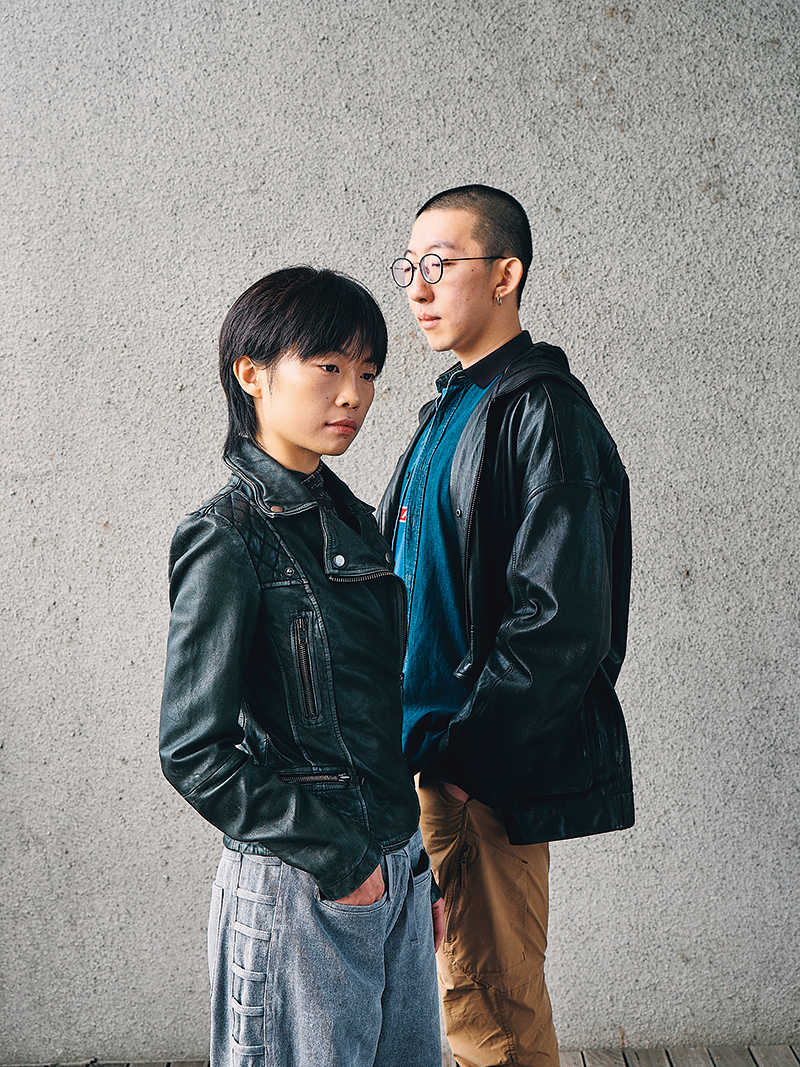
eobchae is an audiovisual production trio that includes Kim Na-hee, Oh Cheon-seok (right), and Hwang Hwi (left). Kim Na-hee is not in the photo as she is currently active in New York. Respecting each other’s critical perspectives, the trio leverages individual interests and skills to showcase original works.
© Heo Dong-wuk
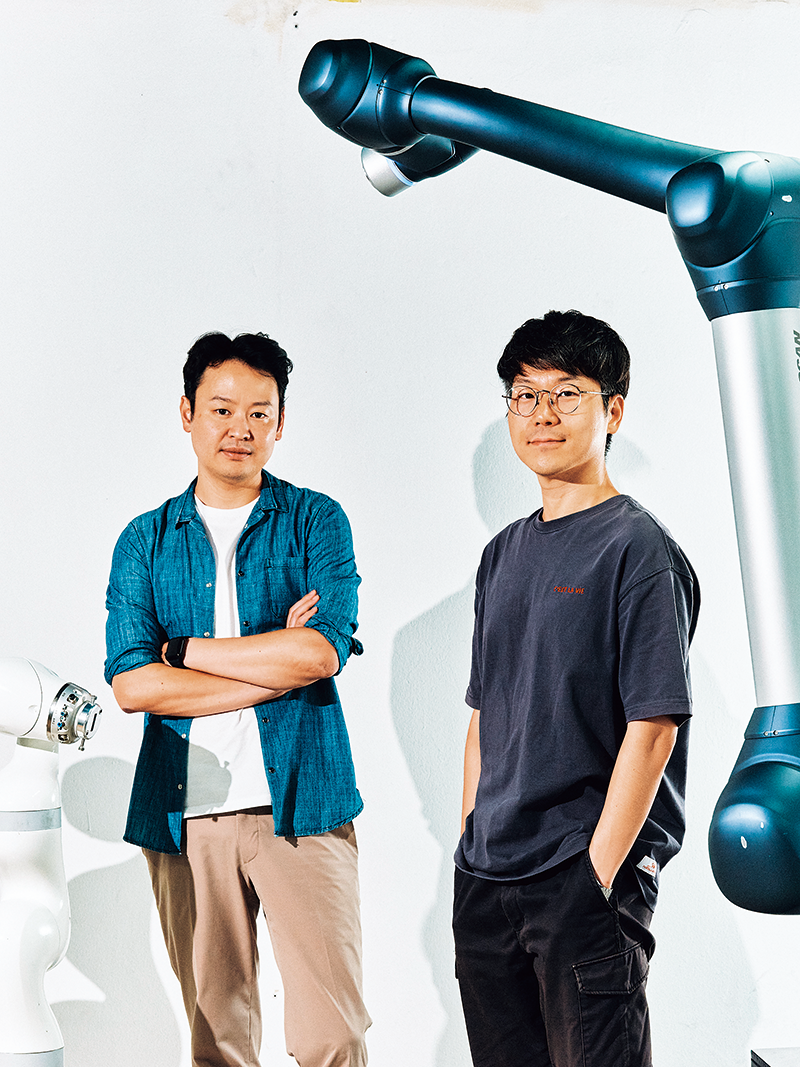
teamVOID was formed by Bae Jae-hyuck (left) and Song Jun-bong. They utilize interactive media, kinetic sculptures, light formations, and robots to visual experiences from a systems perspective.
© Heo Dong-wuk
We’re primarily focused on capturing how technology shapes reality. Fake products that mimic reality are essentially useless, but art provides a useful space and time for them. This allows us to work with a sense of security without having to confront the risks of reality. However, we don’t want to confine our work solely to the language of art, since our work did not emerge from the established art world. We’re not a collective that s works; rather, we discover the most horrifying aspects of today’s technological environment. And yet, in tr ying to make these aspects visible to a larger audience, we seem to end up creating beautiful, interesting, and horrifying things.
teamVOID - A Balanced Art System
teamVOID is a media art collective of engineering majors Bae Jae-hyuck and Song Jun-bong, who began their collaboration in 2014. They blend technology and art to their works, which include interactive media and kinetic sculptures. One of their notable creations is
The Malfunction, a play involving industrial robots.
The duo’s keyword is “systems.” This covers both general, surface-level properties and the complex social phenomena that arise from them, which can be understood as “relationships” and “rules.” For a society to function properly, areas such as politics and culture need to maintain balanced relationships and adhere to their respective rules. Similarly, teamVOID envisions an “art system” where topics, devices, data, and logic integrate harmoniously.
How did you first start out? We were both interested in art from an early age, and we had a creative urge, like many other engineering students. In 2014, I hit on an interesting concept and happened to meet Song in a research lab at school. Working independently can be challenging, especially when you’re not sure where to start or whom to turn to for help. But when you find someone who shares your vision, you often come up with better ideas.
Why call yourself teamVoid? Void is a function in programming. For us, it means a very free and completely uncluttered state of mind. Since neither of us had a visual arts background, we saw ourselves as voids in the field and chose our name with the intention of filling them. While we may not work as extensively as painters or sculptors, we believe that we can challenge the art world through media technology.
Why use robots? It’s fascinating to watch the movements of something neither human nor animal. Tools often reflect people’s desires in a given era. For instance, the desire for mass production is embedded in the conveyor belt, the symbol of the Second Industrial Revolution. Robots represent the contemporary system, and they’re the most common means of production in the Fourth Industrial Revolution. So, what human desire do robots represent? The desire not to work. We go beyond seeing machines as mere tools and instead look at the entire system that makes up a society and represent it through our work.
What about the “backside” of media art?Profound work is often revealed in the “backside,” the part of the work people usually don’t see. The effort creators put into their work may not always be visible on the surface, but when you look deeper, you can feel the passion driving them. We often look at our work and reflect on the thoughts and concerns we had while creating it.
Which new technologies appeal to you? All of them. We try to stay on top of emerging tech trends whenever possible. But we don’t impulsively apply new technologies to our work; first we think about whether they fit the content we want to express. That’s why in some of our works, we’ve used technologies that were introduced several years ago. Adopting a new technology just for the sake of attracting attention is risky.
What is the driving force behind your work? Probably experience and balance. When you experience something new, it satisfies your curiosity and motivates you to try different things and move on to new projects. We’re maintaining our balance as a team by taking on realistic challenges. We owe the past ten years together to a good balance between work and art as well as our teamwork. To keep teamVOID going for the next ten years, it’s important to set long-term directions and strategies.